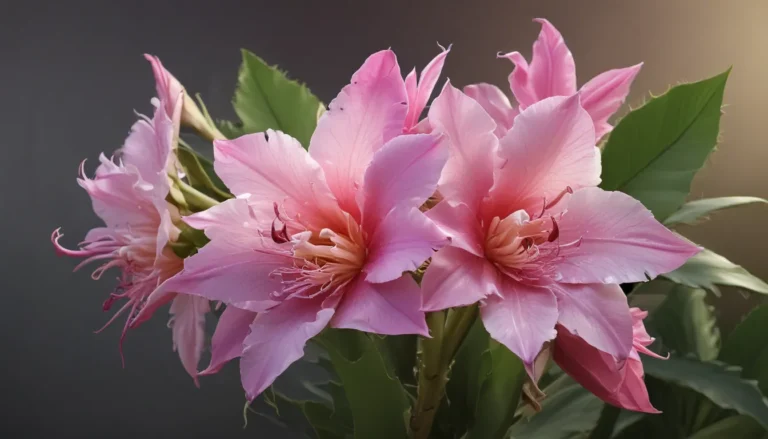The pictures we use in our articles might not show exactly what the words say. We choose these pictures to make you interested in reading more. The pictures work together with the words but don’t take their place. The words still tell you the important facts.
Are you curious about the enchanting world of cinnamon plants? From their botanical features to cultural significance and culinary uses, there's so much to discover about these remarkable plants. Join us as we unravel 20 captivating facts that will deepen your appreciation for the beloved spice that is cinnamon.
Exploring the World of Cinnamon Plants
- Cinnamon Origins: Cinnamon, with its warm and spicy aroma, is derived from the inner bark of Cinnamomum trees, particularly species like Cinnamomum verum and Cinnamomum cassia.
- Ancient Spice: Dating back thousands of years, cinnamon has been cherished for its delightful flavor and medicinal properties, being highly prized in ancient Egypt and even used in embalming rituals.
- Versatile Ingredient: Cinnamon is a staple in both sweet and savory dishes, adding warmth and depth to a wide array of cuisines globally.
The Delightful Journey of Harvesting Cinnamon
- Tropical Origins: Cinnamomum trees, the source of cinnamon, are native to regions such as Sri Lanka, Indonesia, and China, where the ideal climate for cultivation thrives.
- Artful Harvest: Skilled workers carefully peel the bark of the trees to obtain cinnamon, allowing it to dry and form the characteristic cinnamon sticks before being ground into the familiar powder.
The Health Benefits and Medicinal Marvels of Cinnamon
- Antioxidant Power: Packed with antioxidants, cinnamon helps combat oxidative stress and inflammation in the body, contributing to overall health.
- Medical Marvel: Celebrated in traditional medicine for centuries, cinnamon aids in digestion, respiratory issues, and regulating blood sugar levels.
Beyond the Spice Rack: Cinnamon’s Diverse Applications
- Natural Preservative: With antimicrobial properties, cinnamon serves as a natural preservative, inhibiting the growth of bacteria and fungi in perishable goods.
- Aromatic Charm: Cinnamon oil, extracted from the bark, boasts a distinct aroma and therapeutic benefits, finding its way into aromatherapy and wellness practices.
Embracing Cinnamon’s Cultural Significance
- Symbol of Prosperity: Across various cultures, cinnamon symbolizes prosperity and good fortune, being used in rituals, ceremonies, and as a precious gift.
- Festive Traditions: During the holiday season, cinnamon plays a prominent role in crafting aromatic decorations and preparing seasonal treats.
Cinnamon: A Sensorial Journey
- Perfumery Marvel: The alluring scent of cinnamon makes it a sought-after ingredient in perfumery, adding warm and spicy notes to captivating fragrances.
- Beverage Delight: From comforting chai teas to aromatic coffees, cinnamon is a favored flavoring in a variety of beverages, offering warmth and depth.
Indulging in Culinary Splendor with Cinnamon
- Garam Masala Maven: In Indian cuisine, cinnamon is a key component of the spice blend garam masala, enhancing the flavor profile of various dishes.
- Sweet Sensations: Cinnamon's enticing aroma and flavor make it a staple in baked goods, from cakes and cookies to pastries and bread.
Cinnamon Beyond the Kitchen: A Natural Protector
- Insect Repellent: Cinnamon's potent scent acts as a natural deterrent for insects, making it a popular choice for environmentally friendly pest control methods.
Aromatic Aura and Timeless Traditions with Cinnamon
- Seasonal Charm: Celebrated in festive traditions, cinnamon adds joy to the season with its aromatic presence in decorations and treats.
- Cozy Ambiance: The inviting fragrance of cinnamon finds its way into scented candles, creating a warm and cozy ambiance in homes.
The Heartwarming Magic of Cinnamon: From Mulled Wine to Middle Eastern Cuisine
- Mulled Wine Wonder: In traditional recipes for mulled wine, cinnamon lends its distinctive flavor and aroma, making the beverage a winter favorite.
- Middle Eastern Marvel: A staple in Middle Eastern cuisine, cinnamon adds depth and warmth to a variety of dishes, from savory stews to fragrant rice pilafs.
Cinnamon’s Sweet Legacy in Desserts
- Dessert Delight: From classic apple pies to decadent cinnamon rolls, cinnamon is a beloved addition to a variety of desserts, captivating taste buds with its enchanting flavor profile.
In conclusion, the cinnamon plant stands as a fascinating and versatile species that has enchanted humans for centuries. From its rich history rooted in Sri Lanka to its widespread cultivation today, cinnamon continues to be a source of wonder and benefit globally. Whether in culinary creations, traditional medicine, or aromatherapy, the impact of the cinnamon plant on human life is undeniable. Its unique characteristics, diverse applications, and cultural significance make it a truly remarkable botanical treasure.
FAQs: Your Guide to Cinnamon
What are the health benefits of cinnamon?
Cinnamon is believed to offer various health benefits, including potentially lowering blood sugar levels, reducing inflammation, and acting as an antioxidant. Consult a healthcare professional for personalized advice on consuming cinnamon.
How can I grow a cinnamon plant at home?
Growing a cinnamon plant at home can be challenging due to its warm and humid environment needs. Research and understand the plant's specific requirements before attempting cultivation, which is best suited for tropical regions or greenhouse settings.
Whether you're a spice enthusiast, a culinary connoisseur, or simply intrigued by the beauty of nature, the journey through the enchanting realm of cinnamon plants offers a wealth of knowledge and appreciation. Embrace the magic of cinnamon in its various forms, from culinary delights to cultural traditions, and let its aromatic allure captivate your senses and enrich your experiences.






